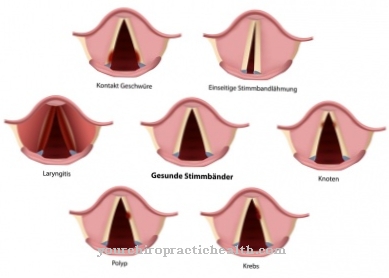The Mucormycosis used to be called Cycomycosis designated. It is the third most common fungal infection after candidiasis and aspergillosis. The disease occurs predominantly in people with an immunodeficiency.
What is mucormycosis?

© PATTARAWIT - stock.adobe.com
The Mucormycosis is a fungal infection with a fulminant course. It is caused by fungi from the zygomycete family. Usually the zygomycetes belong to the saprophytes.
Saprophytes only feed on dead organic matter. In the case of an immunodeficiency, the actually harmless saprophytes can become parasites and cause severe damage to the body. The rhinocerebral form of the disease is particularly feared. The fungi reach the brain via the paranasal sinuses and cause extremely serious damage there.
causes
The causative agents of mucormycosis are filamentous fungi that grow filamentously. Since they are usually harmless, but can cause severe damage under certain circumstances, they belong to the facultative pathogenic fungi. The most common pathogens causing mucormycosis are fungi of the genera Mucor, Rhizomucor, Rhizopus, Lichtheimia and Cunninghamella. The mushrooms are distributed worldwide (ubiquitous) and are mainly found in the ground.
Usually humans are immune to these fungi. If the immune system is weakened, however, they can spread in the respiratory tract, gastrointestinal tract or on the skin. The pathogens penetrate tissue and blood vessels very quickly. Particularly predisposed are patients with diabetic ketoacidosis, patients after a stem cell transplant or organ transplant, as well as patients receiving corticosteroid therapy or people who have severe burns. Patients with T-cell defects or advanced HIV infection are also particularly susceptible to mucormycosis.
Symptoms, ailments & signs
There are five different forms of mucormycosis. All are life threatening:
- The most common form is rhinoorbitocerebral mucormycosis. It is mainly found in children with diabetes mellitus or in leukemia patients. Characteristic symptoms of this form are redness, pain and swelling in the face and eye socket. The infection begins in the paranasal sinuses and causes sinusitis there. The nasal secretions are bloody. In addition, black tissue lesions of the nasal mucous membrane appear.
The thread-like extensions of the fungi break through the skin and grow into the tissue and bones, so that soft facial tissues, the eye socket, the meninges and the frontal lobe can also be affected. The damage to the arteries and veins also leads to increased thromboses and infarcts. Changes in consciousness, central paralysis and visual disturbances indicate an involvement of the central nervous system.
- In the pulmonary mucormycosis especially the lungs are attacked by the fungi. Here, too, there are thromboses and heart attacks. These are often accompanied by fever, shortness of breath and chest pain. Cancer patients with acute leukemia are particularly affected. The infection can arise from rhinoorbitocerebral mucormycosis. As a rule, however, it develops directly in the lungs after the fungal spores are inhaled.
- In children with acute leukemia, this is the most common disseminated mucormycosis. It begins in the lungs and then spreads through the bloodstream to the other organs and the central nervous system. Disseminated mucormycosis is almost always fatal.
- That becomes rarer primary gastrointestinal mucormycosis diagnosed. It is characterized by ulcers in the gastrointestinal tract and occurs predominantly in immature newborns. The ulcers are at risk of perforation. If the pathogen penetrates the blood vessels, infarcts can also occur here.
- The Mucormycosis of the skin shows up in patients with severe burns or in leukemia patients. Black necroses of the skin are typical for this form.
Diagnosis & course of disease
The clinical and radiographic findings are similar to those of other fungal infections. The diagnosis can therefore only be made with the help of cultural, microscopic or histopathological evidence of the pathogen. Diagnostic material can be obtained through biopsies or surgery.
Possible methods of obtaining material are skin or soft tissue biopsies, endoscopy of the nose and sinuses, bronchoscopy with lavage or CT-guided biopsies. In the case of rhinocerebral mucormycosis, diagnostic imaging also reveals a thickening of the mucous membrane in the area of the paranasal sinuses. Pulmonary mucormycosis shows unspecific and extensive lesions of the lungs on X-rays. Spotty infiltrations, melts or pleural casts may be visible.
If the eye socket is affected, a pathological mass appears there. In addition to the pathogen detection, detailed imaging using computer and magnetic resonance tomography is always required. This is the only way to capture the full extent of the infection.
Complications
Mucormycosis can cause various symptoms in the patient. As a rule, this disease must be treated by a doctor in any case, as it can be life-threatening and in the worst case leads to the patient's death. Those affected mainly suffer from severe swelling in the face and also in the eye socket.
Nosebleeds and changes in consciousness occur. Ordinary thinking and acting is now more difficult for those affected and most patients suffer from severe visual disturbances. Without treatment, the patient develops a fever and shortness of breath, which can lead to a loss of consciousness. Chest pain can also occur.
Ulcers form in the intestines or stomach, which can also lead to death. The quality of life decreases significantly due to the mucormycosis and everyday life is made considerably more difficult for the patient. Mucormycosis is treated with the help of medication or chemotherapy. It cannot be predicted whether this will lead to a positive course of the disease. In many cases, life expectancy is significantly reduced by mucormycosis.
When should you go to the doctor?
Mucormycosis should be clarified by a doctor at an early stage. At the latest when typical symptoms such as changes in the skin on the palate and infections in the nose and throat are noticed, a doctor must be consulted. Otherwise, the necrosis may expand further. Signs such as seizures, aphasia, or hemiplegia indicate an advanced disease that needs to be clarified immediately. People with chronic infectious diseases, recurring infections or a generally weakened immune system are particularly susceptible to the development of mucormycosis and should see a doctor as soon as possible if their state of health deteriorates significantly.
The same applies to elderly and sick people, pregnant women and children. In addition to the family doctor, ENT doctors and specialists in infectious diseases are available. Children should always be presented to the pediatrician responsible first. If health problems recur after treatment, the responsible doctor must be informed due to the risk of relapse. Continuous medical supervision is indicated even during the treatment of mucormycosis.
Therapy & Treatment
Mucormycosis therapy is multimodal. The cornerstone is always antifungal chemotherapy. In addition, attempts are made to eliminate the underlying immunological or metabolic defect. This forms the breeding ground for the mushrooms. If the underlying disease is not eliminated, the fungi will spread again after chemotherapy. Treatment is supplemented with antifungal drugs such as amphotericin B.
The duration of therapy depends on the extent of the mucormycosis. Depending on age, pathogen and underlying disease, the mortality is between 50 and 70 percent. Patients only have a chance of survival if there is consistent therapy. The prognosis is worsened by disseminated infections, cancer as the underlying disease and diseases associated with a deficiency of granulocytes. If the central nervous system is reached, the disease is almost always fatal.
Outlook & forecast
Basically, an unfavorable outcome in a mucormycosis can be assumed. According to statistical surveys, 50 to 70 percent of the sick die. The risk of premature death is distributed differently. It increases with other underlying diseases and old age. If symptoms have spread to the central nervous system, death is usually inevitable. In general, people with a weakened immune system and a metabolic disease are considered to be relatively susceptible to mucormycosis. With them, the disease is comparatively severe and usually leads to life-threatening complications.
The therapeutic approaches available to date are mostly inadequate. It is precisely this fact that causes the high mortality rate. In any case, only consistent therapy can contribute to recovery. Starting treatment at an early stage promises better prospects. In practice, it often turns out to be problematic that an exact diagnosis is not possible. In many cases, treatment is therefore initiated on mere suspicion. Only death then allows the disease to be determined. In the recent past, science has developed molecular biological methods for diagnosis. Improvements can be expected from this.
prevention
So far there is no effective and specific prophylaxis for mucormycosis. Mucormycoses in children or adolescents with diabetes mellitus can be avoided by optimally controlling the blood sugar. A permanently high blood sugar level affects the immune system and thus promotes fungal infections.
Aftercare
In most cases of mucormycosis, the person affected has very few measures and options for direct follow-up care. For this reason, the person affected should consult a doctor as early as possible in order to prevent the recurrence of symptoms and complications. In the case of mucormycosis, there is usually no independent healing.
Most of those affected depend on the help and care of their own families. In many cases, this can also prevent depression and other psychological complaints or moods. Furthermore, it is not infrequently necessary to take various medications to completely limit the symptoms of this disease.
Those affected should always ensure that they are taken regularly and that the dosage is correct in order to relieve the symptoms permanently and, above all, properly. As a rule, those affected should also protect themselves particularly well against infections. Vaccinations should also be carried out so that various diseases cannot occur.
In some cases, mucormycosis also reduces the patient's life expectancy. However, the further course depends heavily on the time of diagnosis, so that a general prediction can usually not be made.
You can do that yourself
Mucormycosis must always be examined and treated by a doctor. Medical therapy can be supported by a change in lifestyle and various self-help measures.
The person affected must take it easy during radiation or chemotherapy. A special diet reduces the typical gastrointestinal complaints and helps reduce metastases. At the same time, any allergies must be clarified and medication taken checked and adjusted if necessary. Patients who regularly take headache pills or other drugs should inform their doctor. An optimally adjusted medication lowers the risk of complications and can also promote recovery. If the mucormycosis has already caused thromboses, visual disturbances, paralysis or other problems, these must be treated separately. The doctor will refer the patient to a specialist for this purpose.
The most important self-help measure is to keep a record of complaints and symptoms, because this allows the stage of the mucormycosis to be precisely determined and the optimal treatment selected. In addition, serious complications can be identified and treated at an early stage before a life-threatening condition sets in. Since the fungal infection is a protracted disease, close medical monitoring is indicated even after the initial treatment.





.jpg)





















